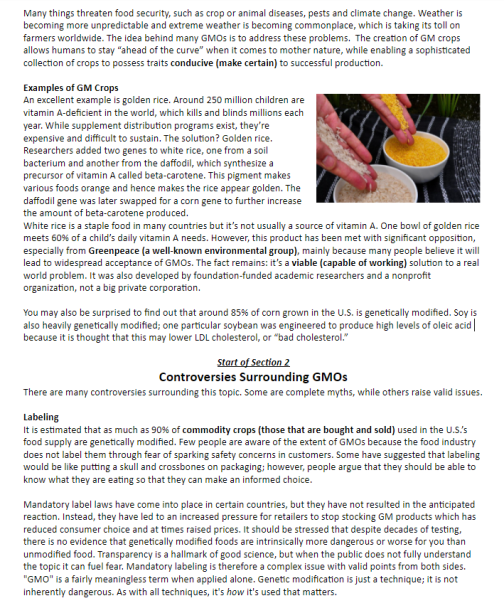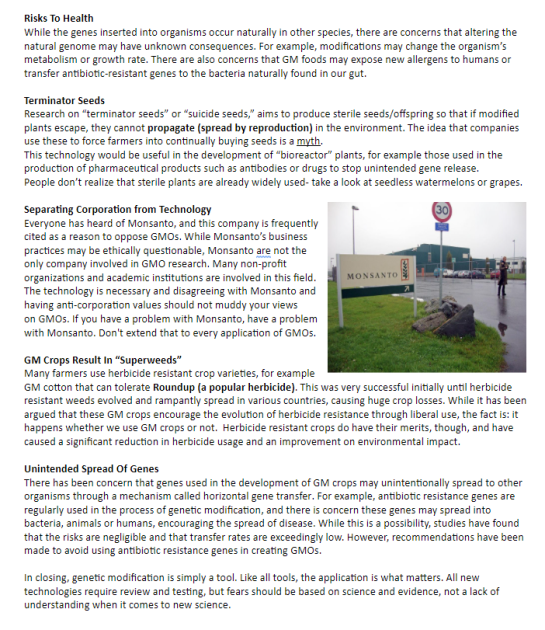What do opponents of labeling GMOs give as their reason for not wanting this distinction visible to the consumer? 6. Regarding the notion that GMOs pose a risk to our health, what are some of the concerns raised regarding this issue? 7. GMOs often have the characteristic of being resistant to herbicides and toxic to pests. How do these characteristics benefit GMOs?
What do opponents of labeling GMOs give as their reason for not wanting this distinction visible to the consumer? 6. Regarding the notion that GMOs pose a risk to our health, what are some of the concerns raised regarding this issue? 7. GMOs often have the characteristic of being resistant to herbicides and toxic to pests. How do these characteristics benefit GMOs?
Human Heredity: Principles and Issues (MindTap Course List)
11th Edition
ISBN:9781305251052
Author:Michael Cummings
Publisher:Michael Cummings
Chapter13: An Introduction To Genetic Technology
Section: Chapter Questions
Problem 2CS: Improving the nutritional value of food has long been one of the goals in agricultural genetics....
Related questions
Question
5. What do opponents of labeling GMOs give as their reason for not wanting this distinction visible to the consumer?
6. Regarding the notion that GMOs pose a risk to our health, what are some of the concerns raised regarding this issue?
7. GMOs often have the characteristic of being resistant to herbicides and toxic to pests. How do these characteristics benefit GMOs?
8. How can you prevent yourself from being misled with false information regarding GMOs? How do scientists determine whether GMOs are safe?

Transcribed Image Text:Many things threaten food security, such as crop or animal diseases, pests and climate change. Weather is
becoming more unpredictable and extreme weather is becoming commonplace, which is taking its toll on
farmers worldwide. The idea behind many GMOS is to address these problems. The creation of GM crops
allows humans to stay "ahead of the curve" when it comes to mother nature, while enabling a sophisticated
collection of crops to possess traits conducive (make certain) to successful production.
Examples of GM Crops
An excellent example is golden rice. Around 250 million children are
vitamin A-deficient in the world, which kills and blinds millions each
year. While supplement distribution programs exist, they're
expensive and difficult to sustain. The solution? Golden rice.
Researchers added two genes to white rice, one from a soil
bacterium and another from the daffodil, which synthesize a
precursor of vitamin A called beta-carotene. This pigment makes
various foods orange and hence makes the rice appear golden. The
daffodil gene was later swapped for a corn gene to further increase
the amount of beta-carotene produced.
White rice is a staple food in many countries but it's not usually a source of vitamin A. One bowl of golden rice
meets 60% of a child's daily vitamin A needs. However, this product has been met with significant opposition,
especially from Greenpeace (a well-known environmental group), mainly because many people believe it will
lead to widespread acceptance of GMO. The fact remains: it's a viable (capable of working) solution to a real
world problem. It was also developed by foundation-funded academic researchers and a nonprofit
organization, not a big private corporation.
You may also be surprised to find out that around 85% of corn grown in the U.S. is genetically modified. Soy is
also heavily genetically modified; one particular soybean was engineered to produce high levels of oleic acid|
because it is thought that this may lower LDL cholesterol, or "bad cholesterol."
Start of Section 2
Controversies Surrounding GMOS
There are many controversies surrounding this topic. Some are complete myths, while others raise valid issues.
Labeling
It is estimated that as much as 90% of commodity crops (those that are bought and sold) used in the U.S.s
food supply are genetically modified. Few people are aware of the extent of GMOS because the food industry
does not label them through fear of sparking safety concerns in customers. Some have suggested that labeling
would be like putting a skull and crossbones on packaging; however, people argue that they should be able to
know what they are eating so that they can make an informed choice.
Mandatory label laws have come into place in certain countries, but they have not resulted in the anticipated
reaction. Instead, they have led to an increased pressure for retailers to stop stocking GM products which has
reduced consumer choice and at times raised prices. It should be stressed that despite decades of testing,
there is no evidence that genetically modified foods are intrinsically more dangerous or worse for you than
unmodified food. Transparency is a hallmark of good science, but when the public does not fully understand
the topic it can fuel fear. Mandatory labeling is therefore a complex issue with valid points from both sides.
"GMO" is a fairly meaningless term when applied alone. Genetic modification is just a technique; it is not
Inherently dangerous. As with all techniques, it's how it's used that matters.

Transcribed Image Text:Risks To Health
While the genes inserted into organisms occur naturally in other species, there are concerns that altering the
natural genome may have unknown consequences. For example, modifications may change the organism's
metabolism or growth rate. There are also concerns that GM foods may expose new allergens to humans or
transfer antibiotic-resistant genes to the bacteria naturally found in our gut.
Terminator Seeds
Research on "terminator seeds" or "suicide seeds," aims to produce sterile seeds/offspring so that if modified
plants escape, they cannot propagate (spread by reproduction) in the environment. The idea that companies
use these to force farmers into continually buying seeds is a myth.
This technology would be useful in the development of "bioreactor" plants, for example those used in the
production of pharmaceutical products such as antibodies or drugs to stop unintended gene release.
People don't realize that sterile plants are already widely used- take a look at seedless watermelons or grapes.
Separating Corporation from Technology
Everyone has heard of Monsanto, and this company is frequently
cited as a reason to oppose GMOS. While Monsanto's business
practices may be ethically questionable, Monsanto are not the
only company involved in GMO research. Many non-profit
organizations and academic institutions are involved in this field.
The technology is necessary and disagreeing with Monsanto and
MONSANTO
having anti-corporation values should not muddy your views
on GMOS. If you have a problem with Monsanto, have a problem
with Monsanto. Don't extend that to every application of GMOS.
GM Crops Result In "Superweeds"
Many farmers use herbicide resistant crop varieties, for example
GM cotton that can tolerate Roundup (a popular herbicide). This was very successful initially until herbicide
resistant weeds evolved and rampantly spread in various countries, causing huge crop losses. While it has been
argued that these GM crops encourage the evolution of herbicide resistance through liberal use, the fact is: it
happens whether we use GM crops or not. Herbicide resistant crops do have their merits, though, and have
caused a significant reduction in herbicide usage and an improvement on environmental impact.
Unintended Spread Of Genes
There has been concern that genes used in the development of GM crops may unintentionally spread to other
organisms through a mechanism called horizontal gene transfer. For example, antibiotic resistance genes are
regularly used in the process of genetic modification, and there is concern these genes may spread into
bacteria, animals or humans, encouraging the spread of disease. While this is a possibility, studies have found
that the risks are negligible and that transfer rates are exceedingly low. However, recommendations have been
made to avoid using antibiotic resistance genes in creating GMOS.
In closing, genetic modification is simply a tool. Like all tools, the application is what matters. All new
technologies require review and testing, but fears should be based on science and evidence, not a lack of
understanding when it comes to new science.
Expert Solution
This question has been solved!
Explore an expertly crafted, step-by-step solution for a thorough understanding of key concepts.
This is a popular solution!
Trending now
This is a popular solution!
Step by step
Solved in 2 steps

Knowledge Booster
Learn more about
Need a deep-dive on the concept behind this application? Look no further. Learn more about this topic, biology and related others by exploring similar questions and additional content below.Recommended textbooks for you

Human Heredity: Principles and Issues (MindTap Co…
Biology
ISBN:
9781305251052
Author:
Michael Cummings
Publisher:
Cengage Learning

Human Heredity: Principles and Issues (MindTap Co…
Biology
ISBN:
9781305251052
Author:
Michael Cummings
Publisher:
Cengage Learning